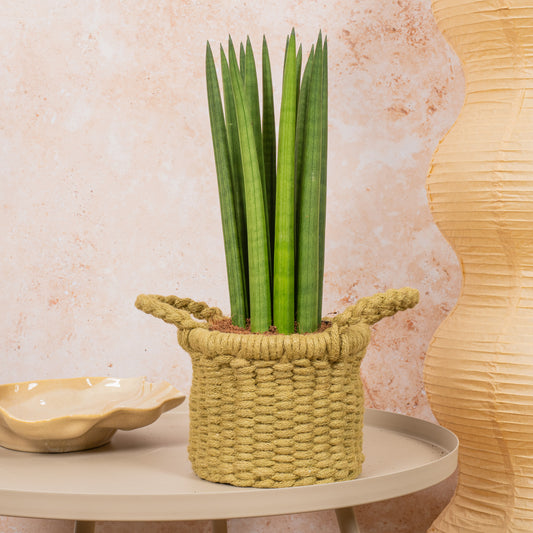Snake plants offer everything you could want from a houseplant. To start with, let's cover the obvious - they look great. Beautiful green, sword like leaves with attractive white stripes, as well as having a striking profile.
Snake plants offer everything you could want from a houseplant. To start with, let's cover the obvious - they look great. Beautiful green, sword like leaves with attractive white stripes, as well as a striking profile, they are a great centrepiece to any indoor plant display.

Like most other house plants, they also help to clean the air that we breathe in our homes - which in turn has a positive impact on our mood, stress levels and productivity. Having one of these delightful little plants next to us throughout the day will help us in so many different ways.
What's more, Snake plants don't take much maintenance at all, so even the novice houseplant owner can help these little beauties thrive! Just to prove it, everything you need to know about Snake Plant care is in this blog - read on to become an expert!
All about Snake Plants
The Snake Plant (Sansevieria trifasciata) hails from Africa originally, specifically the West and South. It thrives in extremely dry air and conditions, which is why they are low-maintenance houseplants. They can survive for a long time without watering. They have developed to thrive in more tropical conditions, and can now be found in the wild in the USA.
They are known by a number of different names, most famously Mother in Law's Tongue on account of their sharp, pointed leaves. A shocking, outdated (slightly amusing) attitude towards mother-in-laws everywhere! They are also known as the Bird's Nest Snake plant.
Snake Plants have become known as wonderful houseplants, perfect to give as a gift to people who are maybe moving house, as you are not lumbering them with something that they are going to need to put a lot of effort in. They get all the joy of owning a houseplant, with little of the responsibility. Snake plant watering is not going to take over your life!
One last point, Snake plants are mildly toxic to humans, cats and dogs, so it's a good idea to keep it out of reach.
Snake Plant Care Guide
There isn't a huge amount that you need to know about caring for an Sansevieria plant, but everything you need to know will be in the section below:
How much light do Snake plants need?
Snake plants thrive in most light conditions. They have adapted to grow in various areas, so they can cope in shaded areas as well as brighter parts of the house. However, to really help them thrive, they should be placed in a bright spot out of direct sunlight.
If you leave them in a dark corner of the house, you may find that some of those striking white lines on the foliage will start to dull a bit, which takes away some of its charm. At the same time, the leaves may start to brown with too much direct sun. The best place to keep your Snake plant is on a windowsill in a well-lit room.

Snake plant watering
We've alluded to this throughout the blog so far, as it is one of the factors that makes it so easy to grow a Snake plant, but just to reiterate; Snake plants will be absolutely fine without regular watering. They are from very dry areas of the world, so are quite happy going without water for a while.
The best way to check whether you need to water your Snake plant is to touch the soil. If it feels very dry and crumbly, it's time for a small drink. If you feel any moisture in the soil, it's best to leave it.
It will require more water during the growing season (Spring and Summer), which will be roughly every couple of weeks, then it will in the Autumn and Winter months.
Overwatering is a much bigger risk to a Snake plant than underwatering. You do not want to let your plant sit in water for any length of time as this could cause root rot. If you see yellow leaves, then this could be a sign that you're overwatering.
Repotting Snake plants
You will probably be able to keep your Snake plant in the original pot that it came in for quite a long time. As they are slow growers, you will find that the root system won't be pushing against the edge of the pot, which is the sign that you need to repot.
When you do decide to repot, it's best to do it in Spring, and use a nice cactus compost soil mix, and make sure you have plenty of drainage holes on the new pot.
Snake plant pests
The main pests for Snake plants are mealybugs. You might spot them on the leaves, and if you do see some, it's best to wipe them off with a damp cloth. The plant would need treated in this case.

How to propagate a Snake plant
While it is possible to propagate a Snake plant from leaf cuttings, the easiest method is by division. All you need to do is cut away a leaf and piece of root with a sharp knife and put that directly in a small pot with some cactus compost. Water it well, and then put your new plant in a bright spot out of direct sunlight - it will grow from there. Simple!
Snake Plant Care - Conclusion
So there you have it, now you know exactly how to care for a Snake plant - there will be no stopping you! There are plenty of Snake plants too choose from, from the Black Coral, with much darker leaves, to the Sansevieria Laurentii - a much taller version of the Snake plant.
But that can just be the start! Have a look at our range of house plants online to see which ones would look great in your home. We have small and large house plants for you to consider, to fit whatever space you're working with.

Craig Wilson
Co-founder and in-house gardening expert at Gardeners Dream.
Craig Wilson, co-founder and director of Gardeners Dream has established himself as a key figure in the online gardening industry. With over 2 decades of plant knowledge and gardening experience, he takes pride in sharing his top tips and tricks for the garden.












